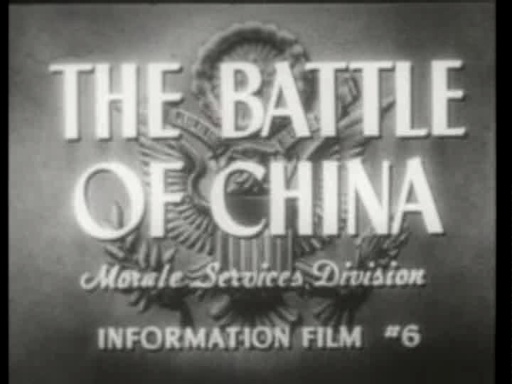- The Battle of China
Infobox Film
name = Why We Fight: The Battle of China

image_size = 250px
caption = The opening of "The Battle of China"
director =Frank Capra ;Anatole Litvak
producer =Office of War Information
writer =Julius Epstein ;Philip Epstein
narrator =Anthony Veiller
starring =
music =
cinematography =Robert Flaherty
editing =William Hornbeck
distributor =War Activities Committee of the Motion Pictures Industry
released = 1944
runtime = 65 min
country = flagicon|US U.S.A.
language = English
budget =
preceded_by =The Battle of Russia
followed_by =War Comes to America
website =
amg_id =
imdb_id = 0184254"The Battle of China" (1944) was the sixth film of
Frank Capra 's "Why We Fight "propaganda film series. It describes the modernhistory of China , with the founding of theRepublic of China bySun Yat-sen , and leads on to the Japanese invasion. The invasion of China is explained in terms of the four-step plan for Japanese conquest, mentioned in theTanaka Memorial .:"Here was their mad dream. Phase One - the occupation of Manchuria for raw materials. Phase Two - the absorption of China for manpower. Phase Three - a triumphant sweep to the south to seize the riches of the Indies. Phase Four - the eastward move to crush the
United States .".Special attention is paid to alleged Japanese atrocities such as the bombing of
Shanghai and theNanking Massacre – the film includes doctored graphic film footage of the Nanking atrocities. The film mentions an alleged Nanking massacre death toll of 40,000 – far lower than modern unsubstantiated estimates; the truth remains unknown.The mass westward migration associated with the moving of the Chinese capital to
Chongqing , and the construction of theBurma Road are also covered, and the film concludes with overview of the Chinese victory at the Battle of Changsha.The
Chinese communists are never explicitly mentioned, but are implicitly acknowledged with a discussion of Chineseguerrilla warfare behind the Japanese lines.The introductory maps shown in the film show China as including
Outer Mongolia andTannu Tuva , as they are, to this day, constitutionally claimed by theRepublic of China , but not claimed by present-dayPeople's Republic of China .References
External links
*
* [http://www.archive.org/details/BattleOfChina "The Battle of China" download] on theInternet Archive
Wikimedia Foundation. 2010.
